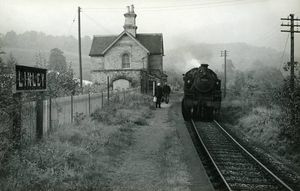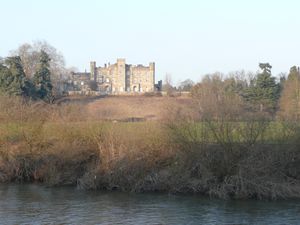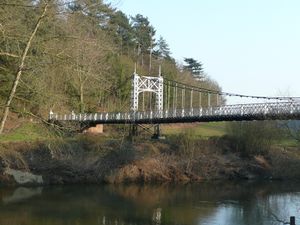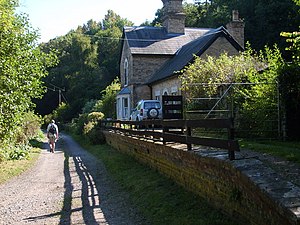Linley
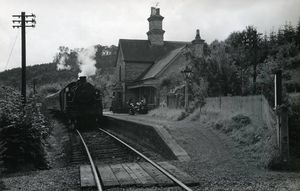
| Towards Hartlebury and Kidderminster | Towards Shrewsbury |
|---|---|
| Bridgnorth (4¼ miles) | Coalport (2½ miles) |
Linley Station was located 22½ miles from Hartlebury and 18¼ miles from Shrewsbury. It was the first station north of Bridgnorth, and had a single platform with no passing loop.
Contents
Construction and history
The Severn Valley Railway passes through the Apley Park estate, owned at the time of the line's construction by Thomas C Whitmore. Although his property was located on the opposite bank of the River Severn, Whitmore opposed the Railway's construction as "utterly annihilating the privacy and seclusion of the said, mansion, house, park and grounds". Whitmore had already sponsored a rival and ultimately unsuccessful proposal, the Shrewsbury, Ironbridge and Bridgnorth Railway whose route was planned to cross the Severn at Quatford, south of Bridgnorth and pass to the east of Apley Park before joining Shrewsbury and Birmingham Railway's Madeley Branch. A Bill to construct that railway was introduced to Parliament in February 1853 but was thrown out in June of that year.[1]
To overcome Whitmore's opposition, the route authorised by the original Severn Valley Railway Act of 1853 included running the line through tunnels under the estate. Negotiations to reduce the cost of the line resulted in a revised route not including tunnels, authorised in the second Severn Valley Railway Act of 1855.[2] To achieve this the Severn Valley Railway Company paid Whitmore £14,000 in compensation as well as £150 per acre for the land purchased, and in addition were required to provide a station at which at least two trains per day in each direction could be stopped on request.[3] Linley Station, built to meet this condition, had no public road access.[2] Although Construction of the Severn Valley Railway began in 1858, Whitmore's land was among the last to be acquired in 1860.
Despite his initial opposition to the railway, Whitmore cut down a number of trees after the railway opened in 1862, so that he could have a better view of passing trains. However he died on 13 March 1865, aged only 58[2] (expectancy would have been about 70).[4]
On 8 June 1862 a porter at Linley left the station a little before midday, having confirmed to the station-master that he would return 'before train time' (5:30pm). In the event he did not return until the following Wednesday morning. He was brought before the South Shropshire Magistrates charged with having "absented himself from the employment of the West Midland Railway Company, without having previously obtained leave or given the required 14 days’ notice". The Bench said the prisoner had rendered himself liable to suffer two months' imprisonment with hard labour, or a penalty of £10. However they had power to mitigate the penalty, and he was to pay a fine of £1 or go to prison for 14 days.[5]
The station was originally accessed from the Hall via a ferry. In 1905 a suspension bridge was built by David Rowell & Co of Westminster.[2]
Traffic statistics
| Passenger Traffic | Freight Traffic | |||||
|---|---|---|---|---|---|---|
| Year | Tickets issued | Parcels despatched | Revenue (£) | Tons received & despatched | Revenue (£) | Total revenue (£) |
| 1903 | 5,280 | 1,506 | 403 | 159 | 71 | 474 |
| 1913 | 4,780 | 1,537 | 433 | 772 | 149 | 612 |
| 1923 | 4,569 | 836 | 462 | 212 | 51 | 513 |
| 1933 | 3,482 | 931 | 303 | 253 | 90 | 393 |
| 1938 | 3,750 | 722 | 263 | 454 | 201 | 464 |
Closure
The station had a goods siding as shown on the OS maps. The short goods loop was removed in about 1939[7] and the siding was closed altogether on 10 September 1951; the station was officially reduced to the status of a halt at the same time.[2]
Following closure of the line in 1963, the station was converted to a private house.
Historic maps of Linley station
- 1883 map showing the station and siding, with the nearby ferry serving Apley Hall also shown
- 1902 map showing the station and siding. A 'points box' is shown giving access to the siding- possibly a ground frame?
- 1927 map showing the station and siding, with the 1905 suspension bridge also shown
See also
References
- ↑ Marshall (1989) p. 24.
- ↑ 2.0 2.1 2.2 2.3 2.4 Marshall (1989) pp. 31-36,107.
- ↑ Vanns (1998) p. 49.
- ↑ Life Expectancy in years at various ages, by decade (Retrieved 1 May 2019)
- ↑ Wellington Journal 28 June 1862, reported in Broseley Papers
- ↑ Nabarro (1971) p. 55.
- ↑ Mitchell and Smith (2007) fig. XIV.
Links
- Wikipedia: Thomas Charlton Whitmore
- Wikipedia: Apley Hall
| ||||||||||||||||||||
